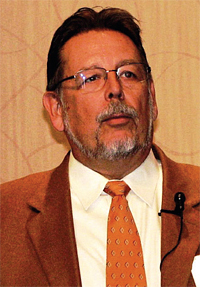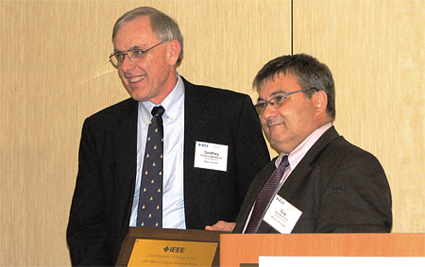When I covered the 1997 IEEE Broadcast Symposium in my RF Technology column in January 1998, the topics included adjacent channel combining, predicting DTV coverage and on-channel repeaters.
In 1997, CompuServe and AOL were the primary way of accessing content online. Internet access and the Web were just starting to take off, but the limited data rates available on dial-up connections and per-minute charges limited content to text and images.
Many of the presentations at the 2011 IEEE 61st Broadcast Symposium covered similar topics—coverage prediction, interference and high-efficiency amplifiers for digital signals. However, the focus this year was on the Internet and its impact on TV broadcasting.
CONNECTED TV
The symposium started with a tutorial on connected TV and closed with a session on the "Future of DTV," which included a paper showing how over-the-air DTV could be integrated with wireless broadband.
Skip Pizzi, director, of digital strategies at NAB, opened this year's symposium with "Connected TV: The U.S. Broadcast Perspective." Pizzi described the concept of "best available screen" as moving content to various locations to allow continuous viewing in-home (or out-of-home); and "hybrid TV" as adding broadband enhancements to broadcast content. Broadcasters need to decide how to balance on-air, Web and hybrid services.
Looking ahead, Pizzi emphasized connected TV is the new TV, with broadcast-only as the baseline service. Broadcasters will need to leverage new usage models, including personalization, targeted delivery and immersive services. Decisions will need to be made on how to deliver "Mobile TV"—mobile apps and wireless streaming—versus "Mobile DTV" broadcasting.
Peter Neuman, from the Technical University of Braunschweig in Germany and Javier Morgade, University of the Basque Country, Spain, presented "Dynamic Broadcast: Joint Optimization of Network Planning and Content Delivery Scheduling." The idea is to send less popular programs ("long tail") content over broadband while using broadcast to distribute popular content.
The authors showed how adopting a distribution structure with dynamic encoder, multiplex, transmitter and even single frequency network configurations depending on demand could reduce the need for spectrum; reduce costs; and lower energy consumption. A key part of the optimization is delivering non-real-time content for storage on viewers' devices using non-real-time transmission.
Papers presented on Friday showed how U.S. broadcasters are addressing changes in the way viewers consume media.
Dr. Rich Chernock, CTO of Triveni Digital, focused on non-real-time (NRT) standards being developed by ATSC in his presentation "ATSC 2.0—What's Next." Chernock outlined the changes in NRT from the current ATSC standards that are currently being worked on for ATSC 2.0. These include connections between live TV and NRT content and Internet content; triggered downloadable/declarative objects (TDO); personalization (preferences, demographics, interests); and two-screen capability—i.e., watching TV and getting additional information on a tablet.
The ATSC 2.0 NRT transport is built on NRT 1.0 methods currently in the ATSC standard and will not impact conventional ATSC reception.
The "next generation" ATSC 3.0 is not constrained by compatibility with current ATSC receivers. James Kutzner, chief engineer with PBS, described some of the areas of development in ATSC 3.0, including increased transmission efficiencies, a different physical layer, and integration with other delivery technologies.
Increased transmission efficiencies could be achieved through new codecs; channel coding and higher-order modulation schemes, and new antenna schemes such as MIMO and MISO.

Mark Aitken. Photo by James O’Neal For the physical layer, carrier-to-noise ratio (C/N) can be sacrificed to allow higher-order modulation and higher bit rates or additional coding added to allow reception at a lower C/N. Kutzner presented a chart comparing the efficiency of multiple coding and modulation schemes in terms of C/N and link spectral efficiency. According to this graph, a VSB-MIMO-STBC-LDC modulation/coding combination or the current A/53 transmission standard with low-density parity check coding (LDPC) performed about the same as the DVB-T2 options at C/N ratios above 5 dB.
BROADCAST OVERLAY SYSTEM
Integration with other delivery technologies includes hybrid TV and a universal broadband broadcasting model, which combines broadcasting and broadband services into a universal service.
Mark Aitken from Sinclair Broadcasting outlined the principles behind a "spectrum-sharing broadcast overlay system" in his presentation "Broadcasting—The Technology and the Medium." Describing this technology would take a full column or more, but I will cover some of the key concepts.
Perhaps the most important concept is that this system would retain the concept of a single stick, high-power, high-height, above-average terrain broadcast transmitter. The system would supplement it with an "overlay" of distributed transmitters to deliver a reliable signal to receivers in areas with weaker signals from the main transmitter due to distance, buildings or terrain at a level of 90 dBµV/m over a station's service area.
While the system would use 3GPP/LTE methods to maintain compatibility with wireless broadband systems and allow sharing, it would require an extension to LTE to scale subcarrier spacing for a longer symbol period. The current LTE parameters are designed for a maximum cell size of 2 km. Mobile network operators (MNOs) use more than 1,000 towers to cover San Diego. The broadcast overlay architecture, with the LTE extensions for broadcast and use of a high-power main transmission site with distributed transmission overlay, would be able to cover the same area with a much smaller number of sites.

Presentation of awards was also part of the IEEE BTS Symposium program. Geoff Mendenhall (l), Harris Broadcast Communications, was awarded the Matti S. Siukola Memorial Award for the best technical paper at last year’s symposium. Guy Bouchard made the presentation. Photo by James O’Neal LTE's evolved packet core (EPC) allows sharing packets between different services (voice, video, data, etc.) with different quality of service. Packet use can be changed depending on demand. This would allow broadcasters to dynamically share bandwidth with MNOs, allowing MNOs to off-load broadcast material (live streaming video, for example) to the broadcast overlay.
Broadcasters would benefit by having their content available on smartphones and other wireless devices with the new LTE chip sets while maintaining the ability to deliver higher bit rate services to portable or fixed TV sets where a higher C/N signal was available.
I found the paper "The Economic Value of Broadcast Innovation—Impact on the U.S. Treasury" covers some of the high points of Aitken's presentation. It is available at coalitionforfreetvandbroadband.org.
In 1998 I would never have thought we'd be discussing the integration of broadcasting with cellular systems. The 128 kbps Ricochet wireless service wasn't widely available until 2001 and Verizon's 1xRTT 153 kbps wireless service wasn't available until shortly after that. Will broadcasters be able to keep up with the changes? There is hope, at least on the technology side.
Next month I'll look at some of other IEEE Broadcast Technical Sympsium topics, including a way to robustly transmit data on an 8-VSB signal without taking bandwidth from the 19.39 Mbps ATSC broadcast.
I welcome your comments and suggestions! Email me at dlung@transmitter.com.
The professional video industry's #1 source for news, trends and product and tech information. Sign up below.

Doug Lung is one of America's foremost authorities on broadcast RF technology. As vice president of Broadcast Technology for NBCUniversal Local, H. Douglas Lung leads NBC and Telemundo-owned stations’ RF and transmission affairs, including microwave, radars, satellite uplinks, and FCC technical filings. Beginning his career in 1976 at KSCI in Los Angeles, Lung has nearly 50 years of experience in broadcast television engineering. Beginning in 1985, he led the engineering department for what was to become the Telemundo network and station group, assisting in the design, construction and installation of the company’s broadcast and cable facilities. Other projects include work on the launch of Hawaii’s first UHF TV station, the rollout and testing of the ATSC mobile-handheld standard, and software development related to the incentive auction TV spectrum repack. A longtime columnist for TV Technology, Doug is also a regular contributor to IEEE Broadcast Technology. He is the recipient of the 2023 NAB Television Engineering Award. He also received a Tech Leadership Award from TV Tech publisher Future plc in 2021 and is a member of the IEEE Broadcast Technology Society and the Society of Broadcast Engineers.
